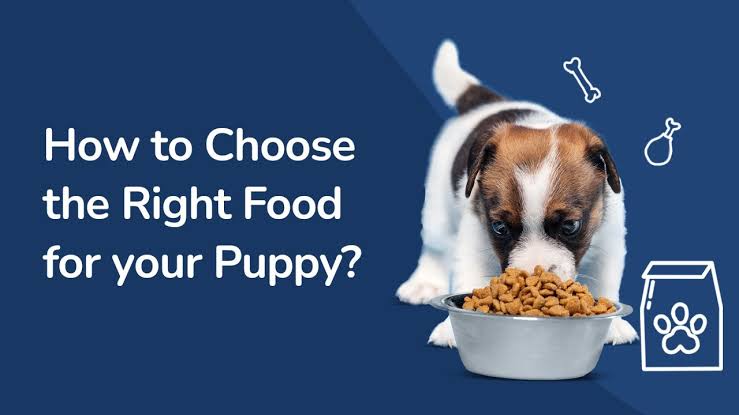
Selecting the right food for your puppy is one of the most crucial decisions you’ll make as a pet owner. A balanced, nutritious diet is essential for their growth, development, and long-term health.

Puppies have different nutritional needs depending on their breed, size, and activity level, which means that a one-size-fits-all approach doesn’t work when it comes to puppy food.
This guide will provide an in-depth understanding of how to choose the best puppy food based on their breed and size, ensuring they get the proper nutrients to grow into a healthy and happy dog.
Choosing Puppy Food for Every Breed and Size: A Comprehensive Guide
Understand Your Puppy’s Nutritional Needs
Puppies go through rapid growth and development, requiring a specific set of nutrients. These include:
- Proteins: Essential for muscle development and overall growth.
- Fats: Provide energy and are necessary for healthy skin and coat.
- Carbohydrates: Provide energy and help with digestion.
- Vitamins and Minerals: Support bone health, immune function, and cognitive development.
- Water: Crucial for hydration and overall bodily functions.
Puppies need food formulated specifically for their age (puppy food) because it provides higher levels of protein and fat compared to adult food. Feeding adult dog food to a growing puppy can lead to malnutrition or growth problems.
Consider Your Puppy’s Breed and Size
Puppy food must meet the specific needs of your dog’s breed and size. Puppies come in various sizes, and the nutritional demands of a tiny Chihuahua are vastly different from those of a large Great Dane.
1. Small Breeds (Up to 20 lbs when fully grown)
Small breed puppies have faster metabolisms and need a diet rich in protein and fat to fuel their growth. They also require smaller kibble sizes for easier chewing and digestion. Because they grow at a different pace than large breeds, small breed puppy food is designed to meet their unique caloric and nutritional needs.
Key Considerations: Small, bite-sized kibble; higher calorie density; high protein (around 30-40%); and healthy fats for energy.
Examples: Chihuahua, Pomeranian, Yorkie, Dachshund, and Maltese.
2. Medium Breeds (21 to 50 lbs when fully grown)
Medium breed puppies, like Beagles, Border Collies, and Bulldogs, need a balanced diet that supports moderate growth. They tend to grow at a steady pace, but their nutritional needs are still higher than those of adult dogs. Food for medium breeds typically contains a balanced ratio of protein, fat, and carbohydrates.
Key Considerations: Moderate calorie density, higher protein (around 25-30%), and balanced fat content.
Examples: Beagle, Bulldog, Cocker Spaniel, Border Collie, and Boxer.
3. Large Breeds (51 to 100 lbs when fully grown)
Large breed puppies, such as Golden Retrievers, German Shepherds, and Labrador Retrievers, grow quickly but are more susceptible to joint and bone issues. As a result, they need food formulated for larger breeds to ensure that their growth rate is controlled and that they receive the necessary nutrients for healthy bone development.
Key Considerations: Controlled calorie content to avoid rapid weight gain, added joint supplements (like glucosamine and chondroitin), and proper calcium to phosphorus ratio (1.2:1).
Examples: Labrador Retriever, German Shepherd, Great Dane, Bernese Mountain Dog.
4. Giant Breeds (Over 100 lbs when fully grown)
Giant breed puppies, such as the Great Dane and Mastiff, have unique nutritional needs due to their massive size and rapid growth. These dogs need a diet that supports bone health while ensuring that their bones grow at a steady pace. Overfeeding or feeding food too rich in protein and fat can cause rapid growth, leading to skeletal and joint problems later in life.
Key Considerations: Limited protein and fat (around 22-24% protein and 8-12% fat), and special attention to bone and joint health with supplements like glucosamine, chondroitin, and omega fatty acids.
Examples: Great Dane, Mastiff, Saint Bernard.
Choosing Food Based on Ingredient Quality
Regardless of breed or size, it is essential to choose high-quality ingredients. Look for brands that use high-quality animal protein as the first ingredient (such as chicken, lamb, or beef), not fillers like corn, wheat, or soy. Real meat provides the necessary amino acids and nutrients for your puppy’s growth.
Animal-based proteins (chicken, beef, lamb, turkey, fish) are highly digestible and support muscle development.
Carbohydrates (brown rice, sweet potatoes, barley) should be easily digestible and provide sustained energy.
Fats (chicken fat, fish oil, flaxseed) are important for healthy skin and coat.
Vegetables and fruits (blueberries, carrots, spinach, pumpkin) provide essential vitamins and minerals.
READ ALSO: The Role of Torsemide in Veterinary Medicine
Age-Specific Considerations
Puppies have different nutritional needs at different stages of their growth. It’s important to feed food designed for their specific developmental stage. Typically, puppy food is formulated for puppies between 8 weeks and 12 months, but it can depend on the breed.
8-12 weeks: A very young puppy requires easily digestible food with higher calorie content to support rapid growth.
3-6 months: Puppies continue to grow rapidly and may need food with more protein and fat.
6-12 months: As growth begins to slow down, it’s essential to feed a well-balanced food that supports healthy bone and muscle development.
Wet vs. Dry Food
Both wet and dry puppy food can offer nutritional benefits. The decision depends on your puppy’s preference, digestion, and your convenience.
Dry food (kibble) is cost-effective, helps with dental health, and is more convenient for storage and feeding.
Wet food (canned food) contains more moisture, making it easier to hydrate puppies who struggle with drinking water. It’s often more palatable for picky eaters but can be more expensive.
Some pet owners choose to feed a combination of both wet and dry food to provide variety and ensure balanced nutrition.
Consider Special Diets or Health Conditions
If your puppy has any specific health conditions, like food allergies, sensitivities, or gastrointestinal issues, choosing specialized puppy food may be necessary. There are various specialized diets available, such as:
- Grain-free: Ideal for puppies with sensitivities to grains like wheat or corn.
- Hypoallergenic: For puppies with food allergies.
- Sensitive stomach formulas: To support puppies with digestive issues.
It’s essential to consult with your veterinarian before making changes to your puppy’s diet, especially if they have specific health concerns.
Portion Control and Feeding Schedule
No matter what food you choose, portion control is important for your puppy’s health. Overfeeding can lead to obesity, while underfeeding can stunt growth. Most puppy food packaging has a recommended serving size based on your puppy’s weight and age. However, it’s always best to monitor your puppy’s body condition and consult your vet for personalized advice.
Puppies generally need to be fed more frequently than adult dogs. A typical feeding schedule may look like this:
- 8 weeks to 3 months: 3-4 meals per day.
- 3-6 months: 3 meals per day.
- 6 months to 1 year: 2 meals per day.
FAQs
Can I switch my puppy’s food suddenly?
It’s recommended to gradually transition your puppy to new food over 7-10 days to avoid digestive upset. Mix a small amount of new food with their current food, gradually increasing the proportion of new food each day.
Should I feed my puppy adult dog food?
No. Adult dog food lacks the necessary nutrients for growing puppies. Puppies need food specially formulated to support their development.
How do I know if my puppy is eating the right amount?
Monitor their weight and overall condition. You should be able to feel their ribs, but they should not be visible. If they are gaining weight too quickly or are too thin, consult your vet to adjust their food intake.
Can I give my puppy treats or human food?
Puppy treats should be given in moderation and should not exceed 10% of their daily caloric intake. Avoid feeding your puppy human food, especially foods toxic to dogs like chocolate, onions, garlic, and grapes.
How do I choose between wet and dry puppy food?
Both wet and dry food have benefits. Dry food is more convenient and helps with dental health, while wet food is higher in moisture and can be easier for some puppies to digest. A combination of both can provide variety and balanced nutrition.
Leave a Reply
You must be logged in to post a comment.